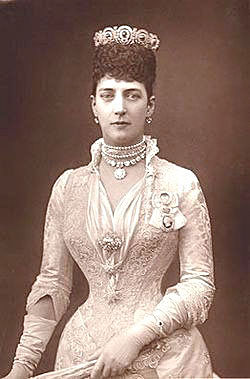 Alexandra, 1844 to 1920, was Princess of Wales from 1863 to 1901 and Queen to Edward VII
1901 to 1910.
Alexandra, 1844 to 1920, was Princess of Wales from 1863 to 1901 and Queen to Edward VII
1901 to 1910.
|
Whenever Britain has been under threat, Volunteers have always responded to the call of the Government and local leaders.
In Anglo-Saxon times men accepted the obligation to serve, if required, in the Fyrd or local militia.
The Vikings divided the North into Wapentakes, literally the "taking of weapons", for the purpose of administration
and the raising of armies. And so it has been throughout Britain's long History.
22 SEPTEMBER 1801. In response to Napoleon's army of invasion at Boulogne the Government
demanded that each area of the country make a return of all available men, weapons, horses etc.
Local Volunteer Associations were
formed and these continued after the threat had receded.
7 JULY 1860. The 1st Administrative Battalion, Yorkshire
North Riding Rifle Volunteers was constituted with a Headquarters at Richmond, N Yorkshire.
Local Volunteer Corps were raised at over 15 places throughout the North Riding.
4 SEPTEMBER 1872. The prize shooting of the Skelton Company of the North York Rifle Volunteers took place at their shooting range
- the Carrs - near Messrs Vaughan and Cos ironstone mines on Saturday last.
Good shooting was made at some of the distances. Besides several money prizes the challenge cup was wond by Private J J Wood and as this
was the third time he won it, it becomes his property.
It is hoped they will endeavour to become as efficient in drill as they evince a desire to become marksmen.
The cup is the gift of their gallant Captain T L Yeoman, who was present. The shooting for the money prizes took place at 200, 400, 500
and 600 yards.
1875. Princess Alexandra, the Princess of Wales presented new colours to the 1st Battalion at Sheffield, and consented to the
Regiment bearing her name, thus becoming the 19th (1st Yorkshire North Riding – Princess of Wales's Own) Regiment of Foot.
|
Men serving in this Unit were mostly recruited from the North Riding of Yorkshire, but were part of the Regular full-time Army.
The Regiment adopted a cap badge consisting of the Princess's cypher "A" combined with the Dannebrog or Danish cross and topped by her
coronet.
[The 4th Battalion would be formed from the local Volunteers and were not associated with this local Regiment of Regulars until the
Territorial Force was established in 1908.]
The Princess became Queen Alexandra in 1901, and was the Yorkshire Regiment's Colonel-in-Chief from 1914 until her death in 1925.
15 JUNE 1880. Re-named the
1st Yorkshire North
Riding Volunteer Corps.
1 FEBRUARY 1883. Re-named the 1st Volunteer Battalion, The Princess of Wales's Own (Yorkshire Regiment)
and the Headquarters was moved to Northallerton, the administrative HQ of the North Riding.
1890. Bulmers Directory for Richmond. 4th Battalion (P.W.O.) Yorkshire Regiment (formerly North. York Rifles) -
R. G. Hopkinson, Colonel; Captain Charles T. Hennah, Adjutant; J. G. Downs, Quartermaster.
11 JUNE 1892. Our Volunteers will go into Camp at Whitby for a week's training with the rest of their Battalion. local Parish
Magazine.
24 JUNE 1893. The Volunteers held their annual camp at Helmsley.
|
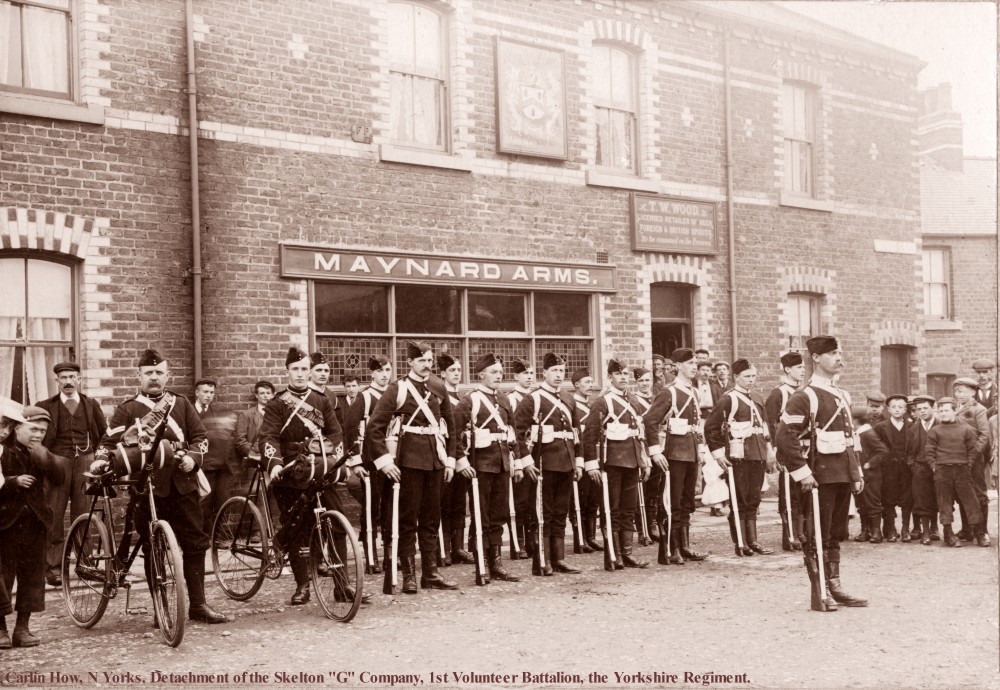
The Maynard Arms, Carlin How, N Yorks.
The men lined up to the Right are almost certainly the Carlin How detachment of the Skelton "G" Company, the 1st Volunteer Battalion, Princess of Wales' Own Yorkshire Regiment.
I am advised by John Sheen that the colours of the Uniform at this time were Red Jacket, Blue Trousers, White Collar, Cuffs and Webbing.
The Rifles are the Long Lee Enfield Mk I.
The Unit to which the two cyclists on the Left belonged is as yet a mystery.
The "Austrian Knot" which they wear on the lower part of the jacket arm has been used to signify an Officer, but the man far Left has the two tapes of a Corporal.
John says that the "Austrian Knot" was also "a dress distinction of Cavalry Regiments, although I believe some Volunteer Artillery and Engineer units wore it. They could be Yeomanry."
The bright uniform colours and white webbing had for a long time been seen as a liability in battle and it is not known when our local Volunteers/Territorial Force were issued with the Khaki Service dress and webbing of the First World War.
Interestingly the Cyclists wear the wrap round puttees used in the War, while the men to the Right still have leather gaiters.
The date of the photograph is now known and no one on it has been identified.
If anyone can add or correct any information, please email the address given on the Introduction page.
[Photograph kindly contributed by East Cleveland Image Archive.]
|
 The 1st Volunteer Battalion, The Yorkshire Regiment at Annual Camp, year unknown.
The 1st Volunteer Battalion, The Yorkshire Regiment at Annual Camp, year unknown.
The only man identified is Pte Harold Clarkson, standing at far right. He was to be killed in action, age 37, near Ypres on
the 29th December 1915.
Photograph kindly contributed by his Grandson, Harold Clarkson of Redcar, N Yorks.
|
"The Corps has grown considerably in number and
the addition of a bicycle Company adds greatly to to the attractions", says one local magazine.
9 JUNE 1894. Skelton - "Sergeant Treen, who has been drill instructor to the Corps for the last fifteen years has
retired on a pension and his place is taken by Sergeant Wright, who has lately been employed as recruiting officer at
Thornaby.
1902. The Battalion was renamed 1st Volunteer Battalion, Alexandra,
Princess of Wales's Own (Yorkshire Regiment). The photograph shown here illustrates the pre-War uniform with white facings,which
was changed to green sometime before the 1908 creation of the Territorial Force.
13 JUNE 1903 Our Volunteers joined the rest of the battalion for their annual week's training under canvas at Scarborough.
The exposed position of their camp on the race course and the inclement weather gave them an experience of the hardships rather than
the pleasures of military
life. Local Parish Magazine.
1906 1st July - Skelton, N Yorks, Parish Magazine - "The Local Volunteers joined those from Scarborough and East
Riding for the annual training in Camp of the Yorkshire Regiment. The place selected was Yarmouth."
1 APRIL 1908.
An Act of Parliament, created by R.B.S. Haldane, the Secretary for War, re-organised the local volunteers nation-wide
into the Territorial Force.
Henceforth they would be attached to their local Regular Army Regiment and use similar equipment and training methods.
|

17 NOVEMBER 1908.
4:th Battalion, Alexandra, Princess of Wales's Own
( Yorkshire Regiment) ; Lieutenant-Colonel and
Honorary Colonel William Henry Mott, from
the 1st Volunteer Battalion, to be Lieutenant-
Colonel with the honorary rank of Colonel,
with precedence as in the Volunteer Force.
Dated 1st April, 1908.
The undermentioned officers, from the 1st Volunteer
Battalion, are appointed to the battalion,
with rank and precedence as in the Volunteer
Force. Dated 1st April, 1908:—•
Major and Honorary Lieutenant-Colonel
William. Henry Anthony Wharton.
Major The Honourable William George Algar
Orde-Powlett.
Captain and Honorary Major (Honorary
Captain in the Army) Maurice Hugh
Lowthian Bell.
|
Captain (Honorary Lieutenant'in the Army)-
Harold Carey Matthews.
Captain George James Ernest'Gardner.
Captain Basil Jackson.
Captain Arthur-John Dorman.
Lieutenant Joseph Walton, junr.
Second Lieutenant William Frederick Mott.
Second Lieutenant Harry Aubone Fife.
Second Lieutenant Bernard Hedley Charlton.
Second Lieutenant Francis Gerald Walker.
Quartermaster and Honorary Captain Alfred
Goat.
The undermentioned officers, from the 1st
Volunteer Battalion, The Durham Light
Infantry, are appointed to the battalion, with
rank and precedence as in the Volunteer Force.
Dated 1st April, 1908 :—
Captain and Honorary Major William
Fleming.
Captain Henry Granville Scott.
Captain Herbert Robert French.
Captain Austin Graham. (To be supernumerary.)
Lieutenant Robert Alfred Constautine.
Lieutenant George Hatton Bowes-Wilson.
Lieutenant William Whitesmith Constantine.
Lieutenant William Gordon Hutchence.
Lieutenant John Vivian Nancarrow.
|
 |
R B S Haldane. 1856 - 1928. As Secretary for War, he was responsible for creating the Territorial Force as well as
other major changes in British Military organisation.
The 4th Battalion, of Alexandra, Princess of Wales's Own Yorkshire Regiment [The Green Howards] was born and
became part of the Territorial Force with Headquarters still at Northallerton.
The Battalion was divided into local Companies designated :-
A - Middlesbrough, [transferred from 1st Vol Bn, Durham Light Inf.]
B - Middlesbrough, [transferred from 1st Vol Bn, Durham Light Inf.]
C - Yarm-on-Tees (detachments at Great Ayton, Stokesley and Hutton
Rudby)
D - Guisborough (dets at Eston, South Bank and Grangetown)
|
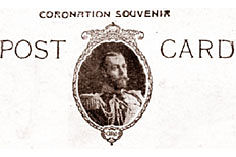
|
E - Richmond (dets at Catterick, Eppleby and Reeth)
F - Redcar (det at Marske by the Sea)
G - Skelton (dets at Carlin How, Lingdale and Loftus)
H - Northallerton (dets at Bedale, Thirsk, Easingwold, Brompton and Helperby)
Each location usually had its own Drill Hall, often with an ex Regular soldier in charge.
Men who joined expected to be used only for Home Defence. like the Militias and Volunteers of old.
They had no obligation to serve overseas.
|
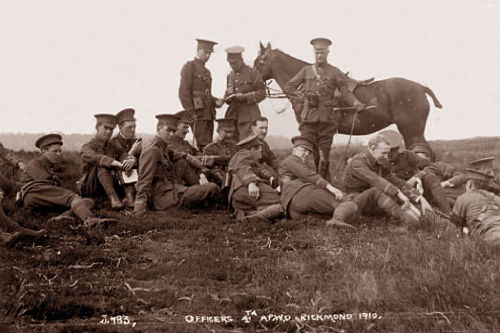 Officers of the 4th Battalion at Richmond in 1910.
Officers of the 4th Battalion at Richmond in 1910.
Only identified is Capt [later Lt Col] W W Constantine, standing Right in front of horse.
[Photograph kindly contributed by Christopher Constantine.]
|
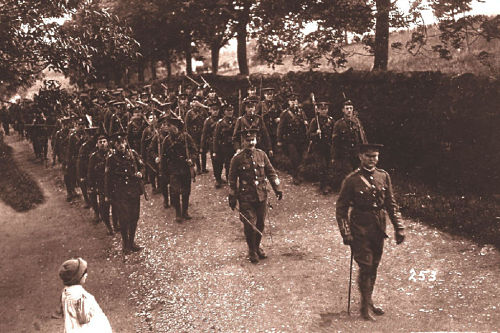 Men of the Bn in 1911.
Men of the Bn in 1911.
A Postcard to mark the June Coronation of George V.
[Photograph kindly contributed by Simon Barnard.]
|
 Officers of the 4th Bn at camp some time before the War. Officers of the 4th Bn at camp some time before the War.
Middle row second from right is Capt [later Lt Col] W W Constantine. Bottom row, Unknown, Unknown, Lt L P I'Anson, 2Lt [later Capt]
H N Constantine.
|
 Men of the Bn in 1911. Men of the Bn in 1911.
Another Postcard to mark the
June Coronation of George V.
[Photograph kindly contributed by Simon Barnard.]
|

Card of 1910. Badge and Regimental Colours.
|

4th Battalion Officers at an Annual Camp. Date of photograph and Ranks at this time not known.
Back row not positively identified.
Middle row, Unknown, W H Colton, H de Legh, not sure, W W Constantine.
Front, J Maughan and A Graham.
Photograph kindly contributed by Christopher Constantine.
|
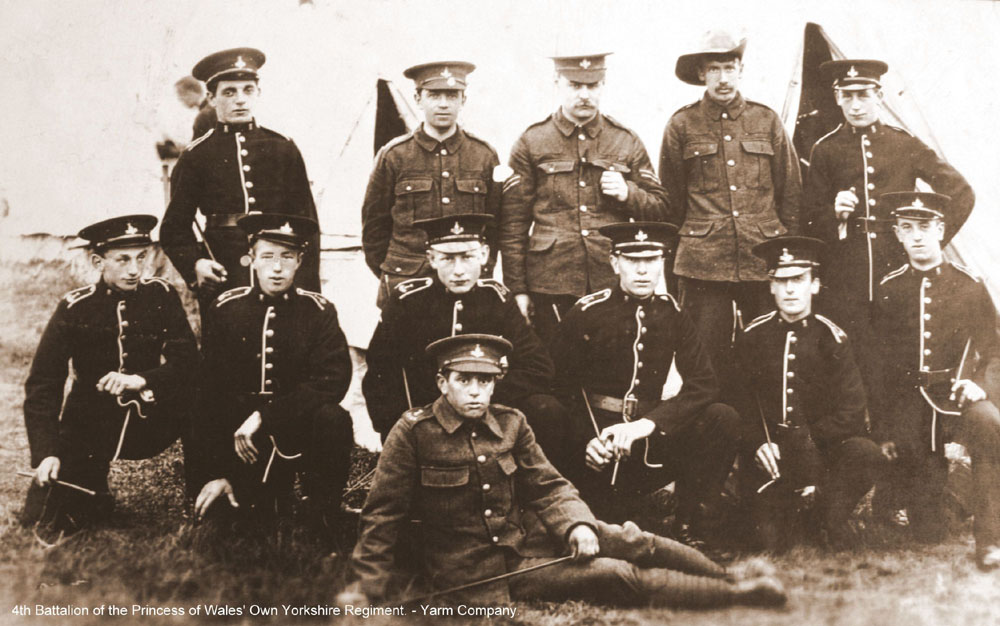
Yarm Company C at Camp 1910.
Back Row - Unknown, Unknown, Cpl Richard George Wallinger [killed Ypres, 24 May 1915], Pte James Walls [gassed Ypres, 24 May 1915], H Page.
Kneeling Middle Row - F White, Unknown, Jeff Wilkinson, Cpl George Grey [killed Ypres 14 Feb 1916], Unknown, Unknown.
Front - Jamesy Swales.
Photograph kindly contributed by Great Grandson of James Walls, Martin Jones, native of Yarm and now living at Ferrensby, nr Boroughbridge, N Yorks.
|
They trained for one or two nights per week and earned the nickname the "Saturday Night Soldiers".
Each Battalion had its own numbering system, with the first man to join being number 1 etc.
In December 1916 an Act was passed to introduce a comprehensive numbering system to cover the Army as a whole and this was introduced for men in the Territorial Force from 1 March 1917.
After this date all men had 6 digit number between 200001 and 240000.
Each year an annual Training Camp was held at different parts of the country and this was an enjoyable event
for many of the men, who in those days never ventured far from home. Sometimes as local as Redcar where they marched in and as far as
Great Yarmouth, Norfolk via the great railway services of those days.
These regular visits to such venues became a regular celebration
by the locals of our patriotism and the Empire with much marching and band playing.
While they were not as efficient as the Regulars, many territorials had been firing guns and accepting
orders since they were 15, having progressed from the Church Lads' Brigade, which was organised on military
lines with similar ranks, annual camps etc.
The Volunteers would turn out for local celebrations, Church Parades etc with the Band playing.
Proud to be members of the Great British Empire.
They were also used to doffing their cap to the local squire and readily accepting the leadership of their
"betters", something that the Great War was to alter.
The 4th Yorks Btn, of course, was one of many.
|
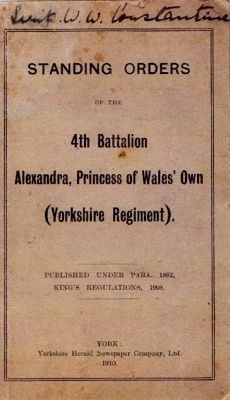
|
The Territorial Force nationwide would produce about 336 Infantry Btns to form 28 Divisions.
Well over a third of Britain's Armies. After the Regular British Army lost half its men in the battles of 1914 they were the men who were
ready and willing and moreover vital to preventing the collapse of the Northern half of the Western Front.
Prior to the War, the "Saturday night soldiers" had been scorned as such by some, but after it General French had no doubt about their
contribution:-
"Equally distinct were the Territorials from what has been called the New Army, whose Officers and men had ample time to prepare
themselves for what they were required to do. I sometimes wonder if the eyes of the country will ever be open to what these Territorial
soldiers of ours have done.
I say, without the slightest hesitation that, without the assistance which the Territorials afforded between October 1914 and June 1915,
it would have been impossible to have held the line in France and Belgium, or to have prevented the enemy from reaching his goal of the
Channel seaboard."
To begin with the 4th Yorks Btn was a purely local force, of about 1000 men.
During the course of the War about a thousand Battalion men lost their lives and probably four or five times that number wounded, taken
prisoner or succumbed to the many ailments that Trench warfare brought on.
To replace this constant loss of personnel re-inforcements were sent out from the 2/4th and 3/4th Battalions that were
formed at home to take over the role of Home defence and training.
As losses increased, conscription was introduced in 1916 and from then on men were necessarily allocated and
transferred to Units on an "as required" basis and local Battalions lost their purely local attachments.
Particularly, many who had enlisted in their local Northants and Cambridgeshire Regiments lost their lives while serving with the
4th Yorks.
Standing Orders, 1910. [Contributed by Christopher Constantine, Grandson of Lt Col W W Constantine.]
|
|



